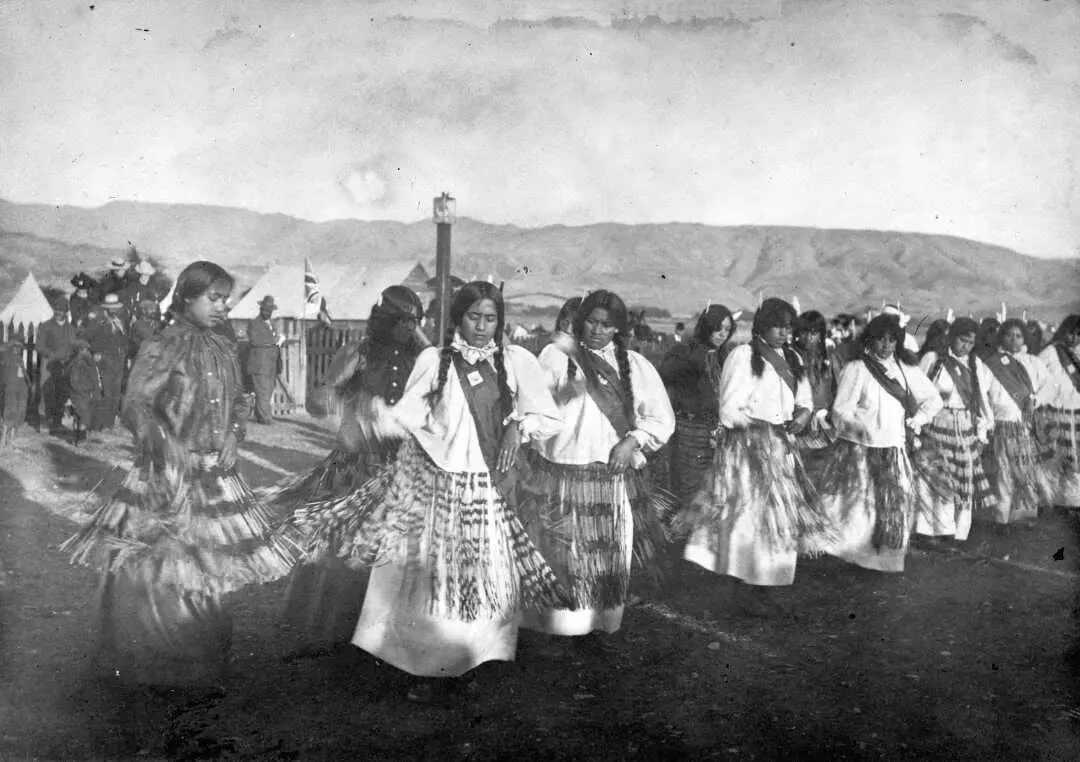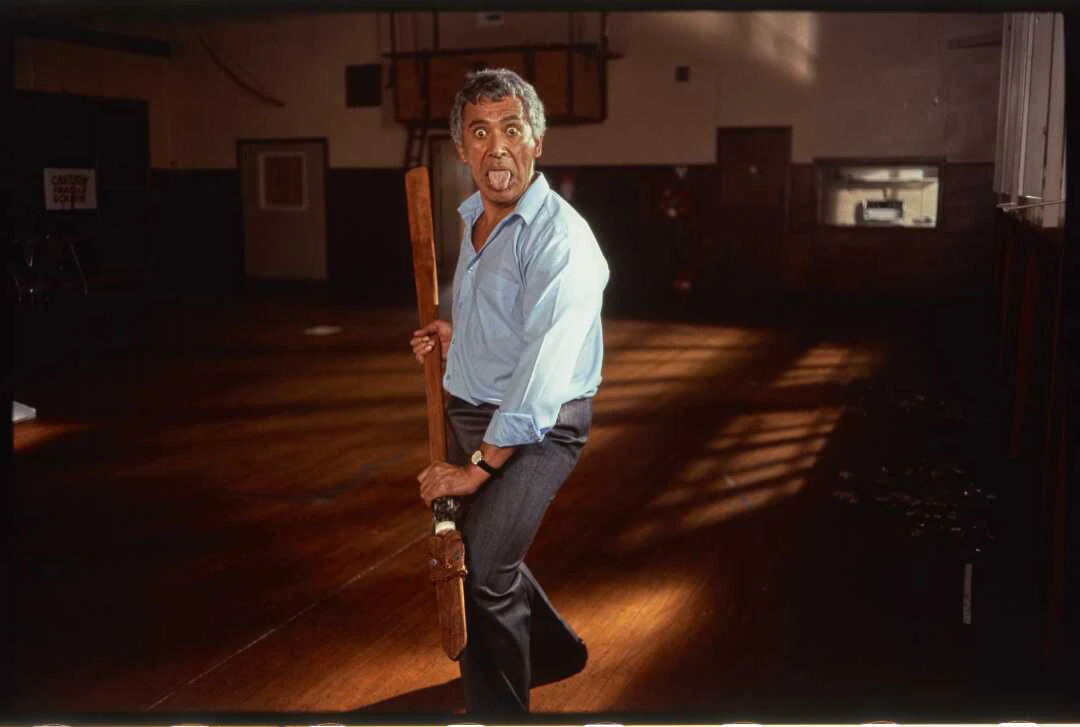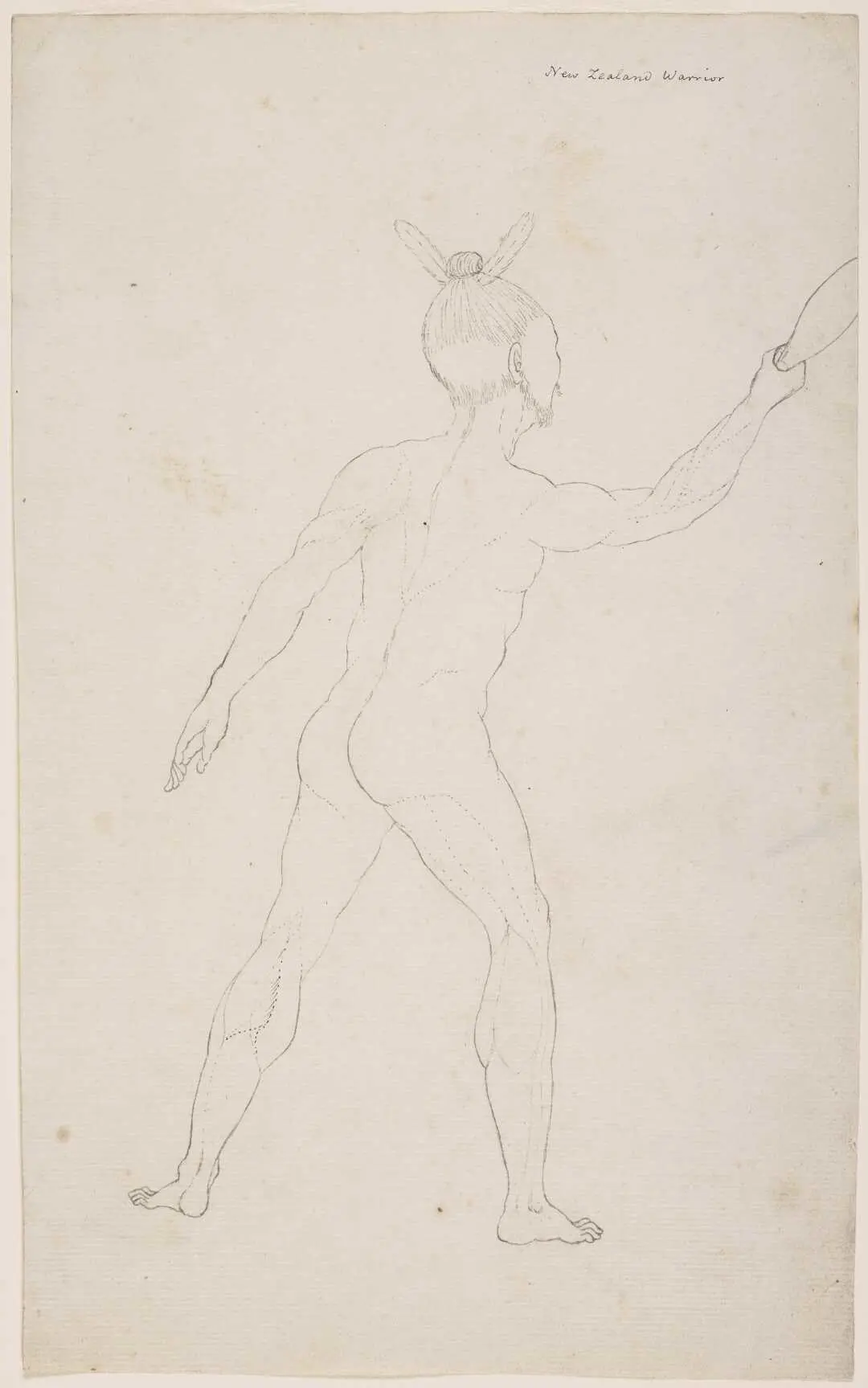
Camera on the shore
Māori perspectives of performance — what is it like to be a performer.
Take an audio tour with Paul Diamond one of the curators of Pūkana. Paul shares stories and highlights from the exhibition.
Listen to Paul Diamond talk about ‘Camera on the shore’ in Pūkana
Transcript — Camera on the shore
Moving from that section of the exhibition over to another part of this first gallery, there's a case with an incredible item in our collection. That's what our colleague Dr. Oliver Steed, who's our curator of drawings paintings and prints, said to us when we were researching for the exhibition is perhaps the first image of a Māori person in the Turnbull collections.
So it's a sketch. It's a pencil drawing by William Wade Ellis, who was the surgeon's mate on Captain Cook's third voyage to New Zealand. So this is we're talking 1777 or possibly slightly later.
And it's a Māori man, sort of, viewed from behind. And he's got one arm down, the other arm his right — his left arm — actually right as we look at it — in the air and he's holding a patu. So you can't see his face. You're looking at him from behind.
And I thought that was interesting, because he's — it's a performance stance. He's maybe speaking. He might be doing haka.
But it's a, sort of, a gesture. He's gesturing to the people that we can't see that are out of the frame. When Ariana saw this, she was interested that it placed the viewer behind the man. So she said, ‘oh, it's like we're on his side, the mana whenua, the home side’, which made us think about one of our ideas for this exhibition is to try and see what's going on in these collections from a Māori perspective.
And then it also reminded me of a quote from Barry Barclay, amazing Māori filmmaker, who talked about this idea of the camera on the shore, the camera in Māori hands in the context of film making and saying what would that look like of Māori had recorded images themselves rather than people from the outside sort of recording images about Māori.
So really it's introducing that idea that in this exhibition we're trying hard to look at our collections in multiple ways, not just from the perspective of the donors who overwhelmingly tend to be non-Māori from Alexander Turnbull forward.
Beside that section of the exhibition is another section called He aha te pūkana?. What is pūkana? Because Fiona Oliver, a colleague I sit next to, said, ‘Well, you probably need to include this, because some people will know what pūkana is. Some people won't know’.
So to introduce that idea to people that we've got some images of pūkana. Now pūkana is where in performance, the eyes move sort of up and down and sideways but the face remains stationary. And it's got all sorts of reasons why it's used in performance.
So we've got a couple of very old images of pūkana, and then we've got a couple of modern images with one is Jim Moriarty and another is George Henare, two still practicing Māori actors.
So that's the, sort of, introductory section of Pūkana, and then the next room in the gallery is looking at really having established this idea of performance in ancient times, where does it go to from there? And there's this idea of rhythm and movement and the origins of haka and poi.
In Māori, our title is ‘Ngā mahi a Tānerorore raua ko Hineruhi’. So Tānerorore is the, sort of, god to do with haka. And Tānerorore is the idea that on a really, really hot day when you see — it's so hot you can see movement. You look out, and you can see movement.
That's the idea of what the wiri wiri performers, sort of, have their hands shimmering and shaking beside them. It's inspired by that idea of the sun on a hot day. And Hineruhi is another deity — it says on our panel here, it's a deity found at dawn whose dances seem to be the sparkle of light that's reflected in the morning dew, and it's particularly associated with female performance.
So Tānerorore is very associated with haka, and Hineruhi is very associated with female performance. So we've got some images of haka and poi. Vicki-Anne Heikell, my co-curator on Pūkana as part of our research found these — found two images that are quite beautiful, and they're side by side in the exhibition. One is of women doing poi in about 1910.
So as was common at that time, they're wearing piupiu, but they wear these big white blouses with big puffy sleeves that were called Mother Hubbard blouses. And they've got sashes and feathers in their hair actually. We don't know where this image was taken. It's supposed to be taken by a man called Joseph Zachariah who's not famous for his images of Māori. He's famous for his images of Wellington.
But he did do one trip to Whanganui to photograph Māori. And we're wondering if this image, which is available online, was taken somewhere on the way up. Because there are hills in the background which could be the hills that you can see from bits of the Kapiti Coast. So that's a little mystery that maybe over the course of this exhibition, we might shed some light.
And then Vicki-Anne placed that alongside a lino cut print by an artist called Hineahuone Coralee Cook, who's actually the mother of a former colleague of ours, Walter Cook. And it's a dance at Te Ore Ore marae in 1937. And it's a beautiful image, because there's a band playing in the top left corner, and there are people dancing. So it's lovely seeing performance in a Māori context, like a wharenui, but also Vicki-Anne sort of liked the sensuality and the idea of performance happening in a private intimate space like that
Any errors with the transcript, let us know and we will fix them: [digital-services@dia.govt.nz](digital.services@dia.govt.nz?subject=Transcript update&body=Please add the link to the page you are emailing us about.)
Mai i te ātea
Mō ngā kohinga a te Whare Pukapuka o Turnbull, nā tauiwi kē te nuinga o ngā tuhinga me ngā pikitia mō ngā mahi waiata, haka, whakakite hoki a te Māori, ā, he iti noa ngā āhuatanga nā te Māori anō i tuhi, i hopu.
Otirā, ki te huri tātou ki tētahi ara whakaaro kē, ka puta tonu tētahi māramatanga mō tō te Māori whakaaro mō te mahi haka, waiata hoki. Kei te inoi mātou ki a koe kia anga kē tō titiro ki ngā whakaaro me ngā kare ā-roto o te hunga whakakite (me ō rātou kaimātakitaki) i taua wā tonu.
Ka hihiri mātou i ngā kōrero a Barry Barclay (Pākehā, Ngāti Apa), i mea rā ia, arā ngā whakaahua o te Māori i hopukina i tawhiti, i tētahi takiwā mamao kē atu, arā kē hoki ngā whakaahua i hopukina e te hinengaro Māori, me mea hopu ki te ‘kāmera Māori . . . he kāmera i roto i ngā ringaringa Māori’. Waihoki, tēnei mātou te inoi ki te hunga peka mai ki Pūkana kia whakaaro mai he pēhea tō te Māori whakaaro mō te whakakite i te haka i te waiata i roto i Te Ao Māori.
The camera on the shore
In the Turnbull Library collections, accounts and images of the way outsiders perceived Māori performance are much more common than those recorded by Māori themselves.
But these same collections can still illuminate Māori perspectives of performance if we think about them in a different way. We’re asking you to think about what it might have been like for the performers (and their audiences) to be in that moment.
We’ve drawn inspiration from Barry Barclay (Pākehā, Ngāti Apa), who contrasted images of Māori captured from a distance, or at a remove, with those filmed from a Māori perspective, taken by what he called ‘a Māori camera . . . a camera in Māori hands’. Similarly, we’re asking visitors to Pūkana to consider how Māori might view performance from within Te Ao Māori (the Māori world).
Performance of a Maori action song. Ref: 1/2-057022-F. Alexander Turnbull Library.

Production still from film ‘Once Were Warriors’ showing character Bennett (George Henare) with a taiaha. He is performing a pūkana. Photograph taken by Kerry Brown or Ann Shelton in 1993. Ref: PA1-q-1172-40-5-RA64/21. Alexander Turnbull Library.

New Zealand warrior, February 1777 or later by William Wade Ellis. Ref:A-264-002. Alexander Turnbull Library.

Feature image at top of page: Visitors enjoying the Pūkana exhibition.
